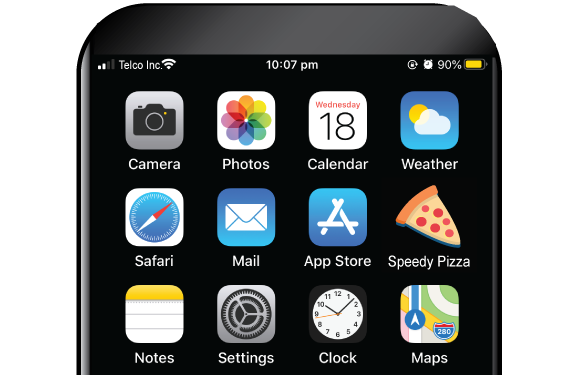Online ordering sites are becoming much more standard for restaurants, but mobile ordering apps are still often overlooked. With mobile food ordering now being a $38 billion industry, and 60% of all digital food orders being submitted through a mobile app, having your food available through mobile apps has never been so important.
That being said, not every restaurant is a great fit for its own mobile app. To help you figure out whether or not an app is the right choice for your pizzeria, we’ve put together a detailed breakdown of the pros and cons of a custom online ordering app.
Pro: Customers Are Able to Support You Directly
Most restaurants that don’t have their own mobile app rely on third-party mobile apps to help increase their digital orders. This will usually include working with one or more of the five major food delivery apps (Uber Eats, Postmates, Grubhub, DoorDash, and Skip the Dishes). But when using these services, you’re forced to give them a small percentage of every order.

Third-party services charge an average fee of 15-25% per order.
On the other hand, any order submitted through your personal app means you keep 100% of the proceeds, which is something that your customers overwhelmingly support. In fact, 70% of your customers prefer to order directly from your restaurant rather than going through a third-party service. By establishing your own mobile app, you can give your customers what they want, while also retaining every cent of your orders.
An often overlooked benefit of not having to give away a share of your profit is that it allows you to keep your prices lower. Competitive pricing is a very effective tool for restaurants, and can be the final nudge that convinces customers to order from you rather than a competitor.
Con: Access to Fewer Customers
One of the biggest advantages of third-party apps is the number of users they have. The two biggest food delivery apps, DoorDash and Uber Eats, have nearly 50 million and 25 million users, respectively. Unless you’re a wildly successful multi-national pizza chain, then chances are that your customer base is nowhere near those numbers.
So by opting to go the route of using your own mobile app, you limit the number of customers that you can expose to your brand. But an easy workaround for this issue is creating your own app while continuing to use third-party apps.
Pro: Appeals to a Younger Customer Base
While it’s true that pretty much everyone loves pizza, there are certain types of people who love it much more than others, with people between 20-39 years old being the most frequent customers.
Something else that people in this age range typically do more often than older customers is use food delivery apps to get their orders. So if you want to appeal to the largest demographic of your customer base, then setting up your own mobile ordering app is one of the best ways to do this.
Con: More Difficult Browsing for Customers
The more intuitive and convenient you can make the ordering process, the more likely you are to get repeat business through your app. Most of the major third-party ordering apps have this down to a science, which is why the main reasons that customers choose third-party food apps over restaurant branded apps are the ease of browsing through items, paying for their food, and looking at prices.
Therefore, if you’re going to offer your own mobile app, it has to be one that makes the ordering experience very convenient. Otherwise, it could cause more harm than good for your customers.
Pro: Integrated Loyalty and Marketing Programs
An important part of restaurant marketing is creating and maintaining a comprehensive customer database. But this is harder to do when your customers are all ordering through third-party apps since these services don’t share customer information with restaurants. By switching to a restaurant-branded ordering app, you ensure that all of the customer data, including customer name, phone number, email, address, and more, are sent directly to your records. You can then use this information in your customer database to market to these people directly.
With your own mobile app, you can also integrate your existing ordering loyalty program, assuming you have one. This will encourage customers to place orders more often so that they can receive rewards. It’s also important that you allow customers to redeem their loyalty points when using the app.

49% of customers spend more when part of a restaurant’s loyalty program.
When it comes down to it, there are plenty of reasons why you should offer a mobile app. As long as you’re okay with taking the slight hit of decreased exposure and are willing to put in the effort to properly market your ordering app, then it’s more than worth it. When you’re ready to set up your online ordering app, check out our article on how to transition customers from third-party services to yours.
Posted on Mon, Jun 14, 2021 @ 08:06 AM.
Updated on June 14, 2021 @ 3:30 PM PST.

